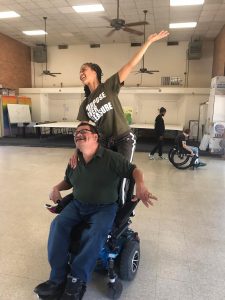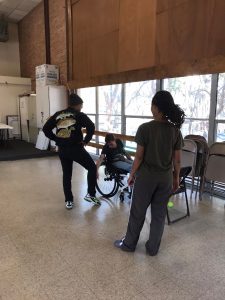By Rebecca Garcia
 I am Rebecca Garcia, a senior Dance Studies student at Texas State University and an intern with Art Spark Texas. I have grown a passion for disability in the dance community after reading one of my peers’ research papers titled, “All Bodies Are Able Bodies.” A statement that stood out to me was, “Close your eyes, whom do you think of when you think of a dancer? Do you picture a tall, thin, white woman in a tutu doing a dance pose or an action pose? Now open your eyes, if you pictured that I’m here to change your mind.” After reading the paper, it redirected my focus in my dance career to work with dancers with disabilities. So, I reached out to one of my professors to get in touch with Art Spark Texas and their dance program to learn more about disability in the arts.
I am Rebecca Garcia, a senior Dance Studies student at Texas State University and an intern with Art Spark Texas. I have grown a passion for disability in the dance community after reading one of my peers’ research papers titled, “All Bodies Are Able Bodies.” A statement that stood out to me was, “Close your eyes, whom do you think of when you think of a dancer? Do you picture a tall, thin, white woman in a tutu doing a dance pose or an action pose? Now open your eyes, if you pictured that I’m here to change your mind.” After reading the paper, it redirected my focus in my dance career to work with dancers with disabilities. So, I reached out to one of my professors to get in touch with Art Spark Texas and their dance program to learn more about disability in the arts.
My focus at Art Spark Texas was being a dancer. I was a principal dancer in the Don’t Dis the Vote Flash Mob. Leading up to the flash mob, all the dancers had gotten together to sit down and process what should be expected at the flash mob. We talked about what the dance movements should look like, what our body language should convey and how we can support one another. It was a great opportunity to go through that process with all the dancers because we listened to each other’s thoughts and creative ideas. It helped me realize that dancers with disabilities are not as restricted as I thought. It is all about communication – what their limit is through specific dance movements, their self-awareness through body contact, and asking permission to use other dancers’ assistive devices.
 I learned about disability culture. For example, a non-disabled person kneeling when talking to a wheelchair user, rather than towering over them, is a sign of seeing a person with a disability as an equal. I never knew this practice because I grew up not knowing anyone with a disability, let alone a dancer with one. However, that is not an excuse. It is something to be educated about because, as a society, it’s a subject matter to recognize.
I learned about disability culture. For example, a non-disabled person kneeling when talking to a wheelchair user, rather than towering over them, is a sign of seeing a person with a disability as an equal. I never knew this practice because I grew up not knowing anyone with a disability, let alone a dancer with one. However, that is not an excuse. It is something to be educated about because, as a society, it’s a subject matter to recognize.
After coming together from processing, we started to dance around the rehearsal space bringing to life the ideas we spoke about. There was so much creativity around the room.
 After rehearsals, all the dancers left with smiles on their faces and were excited to dance at Don’t Dis the Vote Flash Mob. At the end of the day, I asked myself the question, “What do I picture when I think of a dancer?” I did not refer to the tall, thin, white female dancer in a tutu. My vision changed to the principal dancers. I thought about how we all came from different backgrounds in dance, and how I learned to relax when dancing with people with disabilities. Gathering to express ourselves through the art of dance has been one of the best experiences in my dance career. I am fortunate to have gained some knowledge of disability culture during this experience.
After rehearsals, all the dancers left with smiles on their faces and were excited to dance at Don’t Dis the Vote Flash Mob. At the end of the day, I asked myself the question, “What do I picture when I think of a dancer?” I did not refer to the tall, thin, white female dancer in a tutu. My vision changed to the principal dancers. I thought about how we all came from different backgrounds in dance, and how I learned to relax when dancing with people with disabilities. Gathering to express ourselves through the art of dance has been one of the best experiences in my dance career. I am fortunate to have gained some knowledge of disability culture during this experience.
This May of 2022, I will be graduating from Texas State University. My dance career began at 19 years old; I trained in flamenco, modern, modern improvisation, ballet, jazz, and with teaching artists. One day, my goal is to start my own program reaching out to the inner-city kids of San Antonio, with and without disabilities, allowing kids to come and experience dance that I didn’t have when I was younger. My mission in this future program is to foster body positivity and build confidence through the art of dance. Creating a path to show that anyone can be a dancer and a performer, breaking down barriers to the image of what a “perfect” dancer should be.
